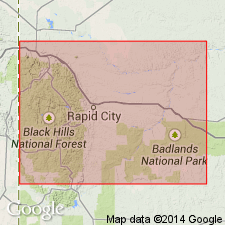
- Usage in publication:
-
- Unkpapa sandstone*
- Modifications:
-
- First used
- Dominant lithology:
-
- Sandstone
- AAPG geologic province:
-
- Chadron arch
- Williston basin
Summary:
First use of name. Intent to name not stated, and no type locality given. Typical sections measured at 12 localities in Black Hills, Williston and Powder River basins and on the Chadron arch. Is a fine-grained, massive sandstone, pink, buff, or purple, 0-225 ft thick, overlying Sundance formation (new), underlying Beulah shale, Morrison formation, or Lakota formation (new) in the Williston basin and on the Chadron arch. Extends continuously from Cascade Springs past Hot Springs all along the eastern side of the Black Hills with its thickness diminishing north of Buffalo Gap. Assigned to the Jurassic.
Source: GNU records (USGS DDS-6; Denver GNULEX).
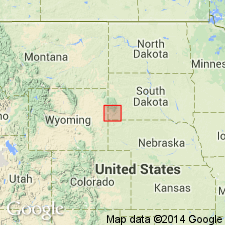
- Usage in publication:
-
- Unkpapa sandstone*
- Modifications:
-
- Named
- AAPG geologic province:
-
- Chadron arch
Summary:
Named for one of the tribes of Dakota Indians which was at one time located about southeast part of Black Hills area on the Chadron arch. Assigned to the Jurassic.
Source: GNU records (USGS DDS-6; Denver GNULEX).

- Usage in publication:
-
- Unkpapa sandstone*
- Modifications:
-
- Overview
- AAPG geologic province:
-
- Chadron arch
Summary:
The type locality is in the ridges east and south of Hot Springs, Fall River Co, SD, on the Chadron arch in the southern Black Hills, where it reaches a thickness of more than 250 ft. The name is from Unkpapa Peak, sec 23, T6S, R6E, Custer County, SD near Buffalo Gap. In the vicinity of the type locality unconformably overlain by Lakota formation; conformably overlies Sundance formation. Assigned a Jurassic age.
Source: GNU records (USGS DDS-6; Denver GNULEX).
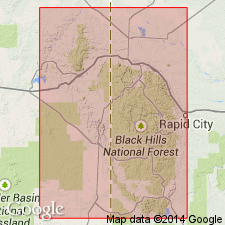
- Usage in publication:
-
- Unkpapa Sandstone*
- Modifications:
-
- Age modified
- Overview
- AAPG geologic province:
-
- Chadron arch
- Williston basin
Summary:
Is a well-sorted, mostly fine-grained sandstone in the Williston basin and on the Chadron arch. High proportions of quartz grains, some feldspar, rare muscovite and schist fragments. Heavy minerals, mostly rounded zircon and tourmaline, very little garnet except in bottom few ft, no chloritoid, hornblende, or apatite (0.062-0.125 mm fraction). Nonopaque heavy minerals are like those in the overlying Lakota Formation except for the bottom few ft. Discusses source and origin. Assigned a Late Jurassic age.
Source: GNU records (USGS DDS-6; Denver GNULEX).
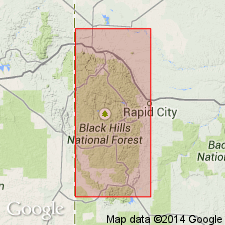
- Usage in publication:
-
- Unkpapa Sandstone Member
- Modifications:
-
- Revised
- Areal extent
- Overview
- AAPG geologic province:
-
- Williston basin
- Chadron arch
Summary:
Assigned to Morrison Formation as its basal member. Unkpapa is interpreted to be eolian facies of Morrison. Bell and Post (1971, USGS Bull. 1063-M) report a distinctive sandstone marker bed conformably below both Unkpapa and Morrison in the Black Hills and they also report that beds of the Unkpapa and Morrison interfinger suggesting that these units were deposited contemporaneously. Outcrops are restricted to part of Cretaceous hogback between Sturgis, Meade CO, SD, Williston basin and Edgemont, Fall River Co, SD, Chadron arch, a distance of about 100 mi. Conformably overlies Redwater Shale Member of Sundance Formation; underlies either main part of Morrison or Lakota Formations both with gradational or disconformable contact. Unkpapa is thickest around southern end of Black Hills, where in outcrop it ranges up to 267 ft near Hot Springs, Fall River Co; is absent a few mi to west of its thickest outcrops. On east flank of Black Hills, average thickness decreases slowly northward from maximum of 300 ft in subsurface until it pinches out near Sturgis. Thicknesses of Morrison and Unkpapa are complementary. Measured sections; stratigraphic column; generalized cross section. Kimmeridgian to Portlandian (Late Jurassic) age.
Source: GNU records (USGS DDS-6; Denver GNULEX).
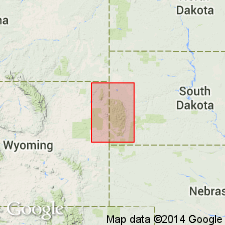
- Usage in publication:
-
- Unkpapa Sandstone*
- Modifications:
-
- Areal extent
- AAPG geologic province:
-
- Chadron arch
- Williston basin
Summary:
Conformably overlies Sundance Formation and underlies Morrison Formation on eastern, northern, and southern flanks of Black Hills in the Williston basin and on the Chadron arch but is not present on western flank where it is replaced by Morrison Formation. Geologic map.
Source: GNU records (USGS DDS-6; Denver GNULEX).
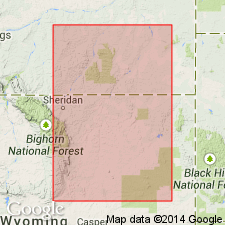
- Usage in publication:
-
- Unkpapa Sandstone Member*
- Modifications:
-
- Overview
- AAPG geologic province:
-
- Williston basin
Summary:
Author follows Szigeti and Fox (1981) who assigned Unkpapa to Morrison Formation as its basal member. Represents eolian sand facies of Morrison. Best developed on east and southeast flanks of Black Hills, SD, Williston basin. Here eolianites thicken at expense of main body of Morrison, and locally constitute total thickness of formation. Conformably overlies Sundance Formation; underlies either main body of Morrison or Lakota Formation. Where Unkpapa underlies Morrison, contact may be conformable and gradational or disconformable and sharp. Where Unkpapa underlies carbonaceous rocks of Lakota, contact is conformable and gradational; where fluvial channel in Lakota has cut down into Unkpapa, contact is disconformable and sharp. Generally thins to north and west, but thickness varies greatly over relatively short distances. Other workers have reported that where Unkpapa is thick, overlying main body of Morrison tends to be thin and where Morrison contains unusually thick Unkpapa, Morrison can be up to three times as thick as nearby sections that do not contain Unkpapa. Maximum exposed thickness is 267 ft; up to 300 ft thick in subsurface. Stratigraphically equivalent eolianites have been described in Black Hills north of zero edge of Unkpapa as well as in central WY.
Source: GNU records (USGS DDS-6; Denver GNULEX).
For more information, please contact Nancy Stamm, Geologic Names Committee Secretary.
Asterisk (*) indicates published by U.S. Geological Survey authors.
"No current usage" (†) implies that a name has been abandoned or has fallen into disuse. Former usage and, if known, replacement name given in parentheses ( ).
Slash (/) indicates name conflicts with nomenclatural guidelines (CSN, 1933; ACSN, 1961, 1970; NACSN, 1983, 2005, 2021). May be explained within brackets ([ ]).

